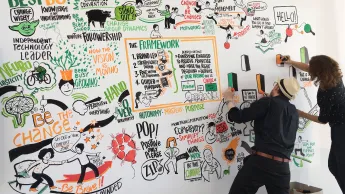Graphic recording: live and in colour
- 2021-11-10
- Eva Lindner
- Comment

Graphic recording means that an event is visually recorded in the form of images that are drawn by a person who is present at the event. Simple metaphors, representations and text are used by the illustrator to capture a group’s discussions, decisions or brainstorming sessions in real time. The final result is not only a structured record of the event but a small piece of art.
How does graphic recording work?
The drawing person listens to a group process, arranges the information and translates it into images drawn on a flip chart, a big projection screen or a tablet computer. Open issues, discussion points or meta levels can be highlighted through the visualisation that allows for new insights. Graphic recording can result in large-scale visualisations that are several square metres in size or in a picture the size of a flip chart. A tablet computer, drawing pad and beamer can be used to digitally transmit the graphic recording.
What makes graphic recording special?
Images are processed more readily by the human brain than words. The drawn record enables the participants to perceive the event on a visual level. Unlike a person taking written minutes, the drawing minute taker is able to represent not only the things said, but also metaphors and comparisons used in speech, and to make nuances and moods visible. At the end of the process, all information is linked in a single image that may even clarify complex correlations that were previously unclear.
Which requirements need to be met?
The drawing person needs a paper wall (flip chart, white board or similar) on site, in a spot where they can hear, follow and record everything. It should be placed within the room where there is plenty of light. The illustrators will usually bring their own pens. A beamer and a projection wall are needed, if the process is to be transmitted by technical means.
Which target groups are suitable for the format?
The format is suitable for grown-ups in education, research, all types of meetings, conferences, workshops and festivities. The illustrator will usually attend the entire process in real time, which can range between one hour and several days.
Special tip
Graphic recording is also referred to as visual recording or scribing. There is a difference to ‘Visual facilitation’: here, the drawing individual is not just attending the process passively, but they comment on the process and point out visualised moods or differences of opinion for the group to discuss.
Continue reading on the Alumniportal Deutschland
20 slides, 20 seconds: a maximum of 6:40 minutes to cover everything. Presenters at Pecha Kucha events give insights e.g. into topics of science, art, or architecture. The most important rule: there must be no room for boredom.20 slides, 20 seconds: a maximum of 6:40 minutes to cover everything. Presenters at Pecha Kucha events give insights e.g. into topics of science, art, or architecture. The most important rule: there must be no room for boredom.
Science speed dating is an opportunity for researchers to answer the questions of interested individuals – and they only have a few minutes to clearly bring across the most important points. From our series on the most effective formats of science communication.
